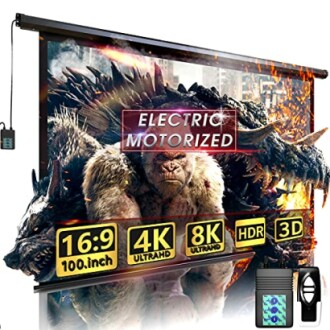
Selecting the Right Projector for Your Home Theater
Key Takeaways
- Understand your space and the ideal projector type.
- Consider brightness, resolution, and screen size for optimal viewing.
- Look for features like installation ease and connectivity options.
- Choose between fixed frame and motorized projector screens for convenience.
- Read user reviews and comparisons to find the best fit for your needs.
Creating an immersive home theater experience begins with selecting the right projector. With the vast array of options available, it can be overwhelming to determine which features align with your unique needs. This guide breaks down the critical factors to consider, helping you make an informed purchasing decision for your high-end home theater system.
Understanding Projector Types
Before delving into specifications, it's essential to understand the different types of projectors available:
- LCD Projectors: Utilize liquid crystal display panels and offer bright, vivid colors. Ideal for bright rooms.
- DLP Projectors: Use a digital light processing chip for sharper images and better contrast, suited for darker environments.
- LED Projectors: Known for their longevity and energy efficiency, producing great colors without bulb replacements.
- Laser Projectors: Provide exceptional brightness and color accuracy, excellent for larger screens and ambient light environments.
Key Specifications to Consider
When selecting a projector, keep the following specifications in mind:
| Specification | Importance |
|---|---|
| Brightness (Lumens) | Higher lumens provide clearer projections in brightly lit rooms. |
| Resolution | Higher resolution (e.g., 4K) delivers sharper images, important for high-definition content. |
| Throw Distance | Determines how far back the projector needs to be from the screen for optimal image size. |
| Contrast Ratio | A higher ratio improves the difference between light and dark areas for a more dynamic picture. |
| Connectivity Options | Ensures compatibility with your devices (HDMI, USB, etc.). |
Choosing the Right Screen
The screen you choose to pair with your projector significantly affects your viewing experience. Here are the main types of screens:
- Fixed Frame Screens: Provide the best tension and surface for picture quality, great for permanent setups.
- Motorized Screens: Offer convenience, particularly for those who want to hide the screen when not in use.
- Portable Screens: Useful for on-the-go setups, easy to carry and install.
Aoxun 100" Motorized Projector Screen
This electric projector screen is perfect for both indoor and outdoor movies, featuring a quiet motor and 4-layer PVC matte screen for optimal image quality.
See ProductInstallation Considerations
Ensure that your projector's installation aligns with your room's dimensions and seating layout:
- Determine the ideal mounting height based on your screen size.
- Consider the throw ratio to calculate the distance between the projector and the screen.
- Plan for cable management to maintain a clean look and prevent clutter.
Comparing Popular Projector Models
To help narrow your options, here’s a comparison of two popular projector screens:
| Feature | Aoxun 100" | VIVIDSTORM 120" |
|---|---|---|
| Screen Type | Motorized | Fixed Frame ALR |
| Screen Size | 100 inches | 120 inches |
| Aspect Ratio | 16:9 | 16:9 |
| Special Features | Quiet motor, easy installation | Ambient light rejection, 8K/4K support |
| Best Use | Home theater and outdoor movies | Home cinema and media rooms |
VIVIDSTORM 120" CineVision Pro Screen
Designed for UST laser projectors, this screen balances superior image quality with special light-rejecting technology to provide stunning visuals in any environment.
Explore NowFinal Thoughts
Choosing the right projector for your home theater involves understanding your specific needs and environment. Keep in mind the projector type, brightness, resolution, and installation requirements. Additionally, selecting a compatible screen can enhance your viewing experience significantly. Don’t forget to check out custom home theater design ideas or our guide on setup tips for an exceptional installation.
Tips for Beginners
- Start with researching space and desired projector types before making a purchase.
- Compare different projector models and screen types based on reviews and specifications.
- Ask for recommendations from friends or online forums to gather real-world feedback.
Pros
- More immersive home viewing experience with a projector.
- Wide screen options allow for bigger displays compared to TVs.
- Flexible installation options, including wall or ceiling mounts.
Cons
- May require a dark room for optimal picture quality.
- Setup can be more complicated than traditional TVs.
- Projector bulbs may need replacing over time, depending on the type.



